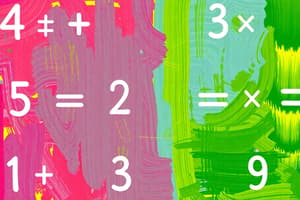Podcast
Questions and Answers
What is the next number in the sequence 2, 4, 6, 8, 10?
What is the next number in the sequence 2, 4, 6, 8, 10?
- 16
- 14
- 20
- 12 (correct)
Which of the following correctly represents the order of operations?
Which of the following correctly represents the order of operations?
- Exponents, Parentheses, Addition, Multiplication
- Parentheses, Exponents, Multiplication/Division, Addition/Subtraction (correct)
- Addition, Division, Multiplication, Subtraction
- Multiplication, Addition, Powers, Parentheses
What is the place value of the digit 5 in the number 3,562?
What is the place value of the digit 5 in the number 3,562?
- 50
- 5
- 5,000
- 500 (correct)
Which of the following problems demonstrates the importance of breaking down complex problems into smaller steps?
Which of the following problems demonstrates the importance of breaking down complex problems into smaller steps?
In the pattern AABBCC, what does each pair of letters represent?
In the pattern AABBCC, what does each pair of letters represent?
What is the process of combining two or more numbers to find their total called?
What is the process of combining two or more numbers to find their total called?
Which of the following best describes subtraction?
Which of the following best describes subtraction?
What is the result of the operation $12 ÷ 3$?
What is the result of the operation $12 ÷ 3$?
In a fraction, what does the denominator represent?
In a fraction, what does the denominator represent?
Which is true regarding decimals and fractions?
Which is true regarding decimals and fractions?
What does geometry primarily focus on?
What does geometry primarily focus on?
What is a pattern?
What is a pattern?
How is multiplication best described?
How is multiplication best described?
Flashcards
Counting
Counting
Numbers used to show how many of something there are, like 3 apples or 5 cars.
Addition
Addition
The process of putting two or more numbers together to get their total.
Multiplication
Multiplication
A shortcut for adding the same number repeatedly. It helps find the total when combining equal groups.
Fractions
Fractions
Signup and view all the flashcards
Decimals
Decimals
Signup and view all the flashcards
Geometry
Geometry
Signup and view all the flashcards
Patterns
Patterns
Signup and view all the flashcards
Sequences
Sequences
Signup and view all the flashcards
What is a pattern?
What is a pattern?
Signup and view all the flashcards
How do you solve a math problem?
How do you solve a math problem?
Signup and view all the flashcards
What is the order of operations?
What is the order of operations?
Signup and view all the flashcards
What is place value?
What is place value?
Signup and view all the flashcards
What is the concept of breaking down a problem?
What is the concept of breaking down a problem?
Signup and view all the flashcards
Study Notes
Numbers and Counting
- Numbers represent quantities or positions.
- Counting determines the quantity of objects.
- Numbers order objects or events.
- Systems like decimals or binary are used for counting.
- Numbers can be expressed as words, digits, or symbols.
Addition and Subtraction
- Addition combines numbers to find the total.
- Subtraction finds the difference by removing one number from another.
- Addition and subtraction are inverse operations.
- Examples: 5 + 3 = 8, 8 - 3 = 5
- Essential for more advanced math.
Multiplication and Division
- Multiplication is repeated addition (shortcut).
- Finds totals in equal groups.
- Division is the opposite of multiplication.
- Separates a total into equal groups.
- Examples: 3 x 4 = 12, 12 ÷ 3 = 4
- Critical for real-world problem-solving.
Fractions
- Fractions represent parts of a whole.
- Written as numerator (top) over denominator (bottom).
- Numerator shows the considered parts.
- Denominator shows total equal parts.
- Example: 1/2 (one-half)
- Can be simplified to lowest terms.
Decimals
- Decimals represent parts of a whole (like fractions).
- Decimal point separates whole and fractional parts.
- Example: 0.5 = 1/2
- Used for measurements and money.
Shapes and Measurement
- Geometry studies shapes (circles, squares, triangles).
- Shape properties (angles, sides, vertices) help describe them.
- Measurement finds the size or amount.
- Common measurements: length, area, volume, time.
- Tools like rulers, protractors, and scales are used.
Patterns and Sequences
- Patterns are repeated sequences of numbers, shapes, or objects.
- Sequences are ordered lists with specific rules.
- Identifying patterns helps predict future values.
- Examples: 2, 4, 6, 8, 10 (increasing even numbers); AABBCC color pattern.
Problem Solving
- Understanding the problem, identifying data, choosing operations (addition, subtraction, multiplication, division), and checking the answer are crucial.
- Break down complex problems into smaller steps.
- Diagrams or drawings aid visualization.
Order of Operations
- PEMDAS/BODMAS order is essential for accurate calculations.
- Parentheses/brackets first, then exponents, multiplication/division (left-to-right), and addition/subtraction (left-to-right).
Place Value
- Place value shows a digit's value based on its position.
- Each place (ones, tens, hundreds,…) has a specific value.
- Understanding is vital for reading, writing, and comparing numbers.
Studying That Suits You
Use AI to generate personalized quizzes and flashcards to suit your learning preferences.




